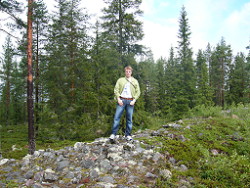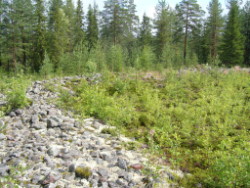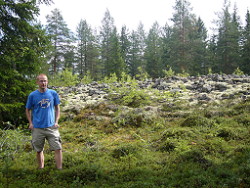
Photo. The author of this article, Stein Morten, explores the large Stone Age ruin of Kastelli at Pattijoki, Finland! © Travel Explorations.
The enormous wilderness in Finland hides a big secret to the world: the huge stone circle of Kastelli at Pattijoki! This monument is notified on the UNESCO tentative list for World Heritages under the name “the large Stone Age ruin of Kastelli at Pattijoki”.
Little is known about this place, and few people except the locals know about it. Despite it’s on the tentative list of UNESCOs World Heritages, there is still limited information to find.
I was lucky with the whether this day. The summer in Finland hadn’t been so well so far this year. In the morning on Wednesday 18 July 2007 the sky was full of dark clouds and it rained heavily, but fortunately when I and my guide Samuel Vaneeckhout arrived at the ancient site, sun rays brought trough the dark clouds, and illuminated the huge stone circle. For me it was just like a acopalypse. When the sun started to shine, big mosquitoes emerged, and soon they were all over me. It was not easy to be concentrated when I explored the site with these insects wildly attacking me.
The area around the stone complex was surrounded with dense pine forest and with open marshes. Before we took a closer look at the stone circle, we observed a big hole in the ground. So we walked up to the top of the stone circle, and got a god overview of the total circle and the middle of it. According to my guide, had nothing been found inside or outside the circle.
| Photo. An amazing wonder in Finland, the large Stone Age ruin of Kastelli at Pattijoki. © Travel Explorations. |  |
The stone monument at Pattijoki it’s not so spectacular as the Stonehenge outside London, but the mysterious surroundings and the unique construction make it really special. This type of construction, which according to legend was built by giants, is only found in the coastal areas of the Gulf of Bothnia.
There are about 35 - 40 known constructions in Finland of this kind, according to my guide Samuel Vaneeckhout, a researchers from the Oulu University – Oulun Yliopisto - in Finland. They are smaller, and most of them are destroyed. Samuel is from Belgium, specialised in Finnish ancient heritage, and one of the area is keen to explore is this one.
Many of Finland`s well kept secrets from ancient time are hidden deep in the country`s forests. Samuel told me that he has brought 3 months alone in a forest for some time ago doing research work in Finland. He was really keen to find out more about Finnish ancient history.
| Photo. My guide Samuel Vaneeckhout stands in the front of the large Stone Age ruin of Kastelli at Pattijoki, Finland! © Travel Explorations. |  |
Kastelli at Pattijoki is the largest of stone structure found in Finland: as described by UNESCO (according to information on UNESCO`s website), it’s a rectangular rampart measuring 36 x 62 meters built in an area which used to be a rocky shore. The rampart, which is two meters high in its present state, has six gateways.
In the environments there are more than twenty rock cairns, a representative group of ten trapping holes and a Stone Age dwelling site lower on the slope. Excavations were made at Kastelli in the 1920s. The findings, especially the schist material, date the "giant's church" of Kastelli at about 2000 BC.
It was strange for me standing on steady ground near the stone monument thinking of that it has been sea water around here before. That’s why the stone monument was built on the ridge. When the sea vanished, the people also vanished. Where the people who lived here in ancient time moved, no one knows.
Photo. Me standing in the front of the big circle dreaming about the past. © Travel Explorations. The photo is taken from a place where it was sea before. |  |
Kastelli at Pattijoki represents the earliest monumental construction in Finland in a form which is rarely found in hunter-catherer cultures.
My guide Samuel Vaneeckhout told me enthusiastically about the ancient site. There are several theories about the purpose of the stone monument. The most important of them are:
• Fortress: wall for protection in war - set up on the highest spot for getting a good view, and for making it difficult for intruders to get in
• Ritual site
• Slaughter house for killed animals and for preparing food
• Storage for food
• Big kitchen for cooking
• Marker in the landscape
• Natural made from the nature - not build by humans
• Watch tower for viewing animals for hunting activities
It is likely that the construction was related to the hunting of seals on spring ice away from dwelling places. It’s believed that the stones used to build the stone monument were found nearby. Some parts of the monument seem to be based on natural stones, and other parts seem to be built by people.
The wall is also believed to be much higher than it looks today. The rampart is surrounded by stone cairns, which probably represent the remains of holes made for the keeping of killed animals. Now I could see flowers, grass and small threes growing in the middle of the stone circle. It was almost on the same ground level as the stone, so it`s hard to imagine that it probably has been a high wall there.
Photo. A hole probably made for storing food from captured animals.
It seems that people building this stone structure has been well organised. It has been a big job to build this huge monument. They have probably been in contact with people living in Norway, Sweden, Russia, Baltic countries and other neighbouring countries. In the summer this people used the sea way, and in the winter they were skiing.
Stone structures in Finland is limited to the northern part of the country and connected to the coastline. It’s not found any stone structure south for the Finnish city Wasa.
The village found nearby, with 7 - 8 rowhouses, has similarities with how the Inuits and Indians built their houses. The houses are built half underground so it could work better as shelter against wind and coldness.
This enormous ancient monument complex has been preserved nearly in its original and natural state. Today the monument is a good place for local people to meet for orientation in the landscape. It’s still important for people hunting and picking berries in the area. And it’s also a marker for the few people who live around in the forest. But this has nothing to do the original function, explained my guide Samuel.
There are still excavations going on in the area. My guide Samuel wonders if it could be something under the structures, but the government don’t allow anyone to dig there. Anyway researchers hope to find more out about the people who lived in the area in the past and the purpose of their stone monuments.
Finnish wonders on UNESCO`s tentative World Heritage List: Finnish wonders.
People have trough history moved from place to place dependent of whether, climate, and sources for food. Climate change and geography change, but the huge stone monument from ancient time still stands. It’s Finland’s unforgettable heritage telling its own story, but still some parts of the story wait to be unveiled by researchers.
Stein Morten Lund, 21 August 2007
Additional information
I would like to thank my guide Samuel Vaneeckhout for interesting information and an interesting journey back to Finland`s Stone Age.
So far Finland has seven sites on the UNESCO World Heritage list. The authorities in the country work now for adding one more: the Gold area in Lapland.
Websites for more information: www.unesco.org.
General information about stone circles:
Stone circles have amazed and confused people for centuries. Do you know that stone circles are quite common in the prehistoric time? There are found stone circle in several places in Europe, Amazon and Africa. For example: Over one hundred prehistoric stone circles survive in the Gambia, built over a period of some fifteen hundred years, from the 3rd Century BC to the 13th Century AD, in at least 34 sites.
In many cases it`s generally believed that stone circles as the Stonehenge has functioned as an astronomical calendar associated with the sun and moon. Some suggest that some of stone circles around the world also had a sacred temple function.
Stone circles are ancient monuments. They are not always circular and often form an ellipse as the large Stone Age ruin of Kastelli at Pattijoki. In Scandinavia, there was a tradition of making stone circles during the Iron Age and especially in Götaland. Based on archaeological discoveries combined with information from astronomy, geology and mathematics, researchers believe that the purpose of stone circles was connected with prehistoric peoples' beliefs, and their construction can be used to infer about ancient engineering, social organisation, and religion. Their precise function however, is unknown, and will still be discussed. Maybe the stone circles had many functions, and their purpose might vary from place to place.
General information about the Stone Age in Finland:
Read more about the Finnish Stone Age on our website www.TravelExplorations.com.
……at the Kierikki Stone Age Centre in Finland, I really was really amazed to find boomerangs displayed in a museum….
The earliest stage of occupation is called the Stone Age (c. 8000-1300BC). During that time tools, weapons and ornaments were made of stone or other organic materials like bone and wood. The population lived by hunting and fishing and the animals most important to them were the elk, the seal and the beaver. At the very end of the Stone Age agriculture and cattle breeding made their first appearance in Finland.
Finland has the oldest bedrock in EU. It was found in the Siuruankangas heath in the village of Siurua. The rather modest looking rock dates back 3,5 billion years.
Kierikki Stone Age Centre, Yli-Ii, Finland.
Kierikkicenter, Pahkalantie 447, 91200 Yli-Ii.
Phone Customer service: +358-8-8170 490
E-mail: asiakaspalvelu@kierikki.fi
Website: www.kierikki.fi
Recommended book about Heritages and Cultures in Finland:
By the Rivers – The Cultural and Nature Route pf Oulu Arc, Kierikki Stone Age Centra, Sini Annala & Sami Viljanmaa.















